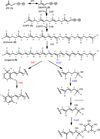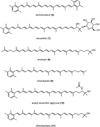Sioxanthin, a novel glycosylated carotenoid, reveals an unusual subclustered biosynthetic pathway
- PMID: 25329237
- PMCID: PMC4755588
- DOI: 10.1111/1462-2920.12669
Sioxanthin, a novel glycosylated carotenoid, reveals an unusual subclustered biosynthetic pathway
Abstract
Members of the marine actinomycete genus Salinispora constitutively produce a characteristic orange pigment during vegetative growth. Contrary to the understanding of widespread carotenoid biosynthesis pathways in bacteria, Salinispora carotenoid biosynthesis genes are not confined to a single cluster. Instead, bioinformatic and genetic investigations confirm that four regions of the Salinispora tropica CNB-440 genome, consisting of two gene clusters and two independent genes, contribute to the in vivo production of a single carotenoid. This compound, namely (2'S)-1'-(β-D-glucopyranosyloxy)-3',4'-didehydro-1',2'-dihydro-φ,ψ-caroten-2'-ol, is novel and has been given the trivial name 'sioxanthin'. Sioxanthin is a C40 -carotenoid, glycosylated on one end of the molecule and containing an aryl moiety on the opposite end. Glycosylation is unusual among actinomycete carotenoids, and sioxanthin joins a rare group of carotenoids with polar and non-polar head groups. Gene sequence homology predicts that the sioxanthin biosynthetic pathway is present in all of the Salinispora as well as other members of the family Micromonosporaceae. Additionally, this study's investigations of clustering of carotenoid biosynthetic genes in heterotrophic bacteria show that a non-clustered genome arrangement is more common than previously suggested, with nearly half of the investigated genomes showing a non-clustered architecture.
© 2014 Society for Applied Microbiology and John Wiley & Sons Ltd.
Figures





Similar articles
-
Influence of Cultivation Conditions on the Sioxanthin Content and Antioxidative Protection Effect of a Crude Extract from the Vegetative Mycelium of Salinispora tropica.Mar Drugs. 2021 Sep 8;19(9):509. doi: 10.3390/md19090509. Mar Drugs. 2021. PMID: 34564171 Free PMC article.
-
Genomic insights into specialized metabolism in the marine actinomycete Salinispora.Environ Microbiol. 2017 Sep;19(9):3660-3673. doi: 10.1111/1462-2920.13867. Epub 2017 Aug 14. Environ Microbiol. 2017. PMID: 28752948 Free PMC article.
-
Engineering Salinispora tropica for heterologous expression of natural product biosynthetic gene clusters.Appl Microbiol Biotechnol. 2018 Oct;102(19):8437-8446. doi: 10.1007/s00253-018-9283-z. Epub 2018 Aug 13. Appl Microbiol Biotechnol. 2018. PMID: 30105571 Free PMC article.
-
Structure and Candidate Biosynthetic Gene Cluster of a Manumycin-Type Metabolite from Salinispora pacifica.J Nat Prod. 2022 Apr 22;85(4):980-986. doi: 10.1021/acs.jnatprod.1c01117. Epub 2022 Mar 9. J Nat Prod. 2022. PMID: 35263117 Free PMC article. Review.
-
Interpreting Microbial Biosynthesis in the Genomic Age: Biological and Practical Considerations.Mar Drugs. 2017 Jun 6;15(6):165. doi: 10.3390/md15060165. Mar Drugs. 2017. PMID: 28587290 Free PMC article. Review.
Cited by
-
Gene Flow and Molecular Innovation in Bacteria.Curr Biol. 2016 Sep 26;26(18):R859-R864. doi: 10.1016/j.cub.2016.08.004. Curr Biol. 2016. PMID: 27676308 Free PMC article. Review.
-
Exploring the Valuable Carotenoids for the Large-Scale Production by Marine Microorganisms.Mar Drugs. 2018 Jun 8;16(6):203. doi: 10.3390/md16060203. Mar Drugs. 2018. PMID: 29890662 Free PMC article. Review.
-
Complete Genome of Micromonospora sp. Strain B006 Reveals Biosynthetic Potential of a Lake Michigan Actinomycete.J Nat Prod. 2018 Sep 28;81(9):2057-2068. doi: 10.1021/acs.jnatprod.8b00394. Epub 2018 Aug 15. J Nat Prod. 2018. PMID: 30110167 Free PMC article.
-
Family-wide Structural Characterization and Genomic Comparisons Decode the Diversity-oriented Biosynthesis of Thalassospiramides by Marine Proteobacteria.J Biol Chem. 2016 Dec 30;291(53):27228-27238. doi: 10.1074/jbc.M116.756858. Epub 2016 Nov 14. J Biol Chem. 2016. PMID: 27875306 Free PMC article.
-
Vertical Inheritance Facilitates Interspecies Diversification in Biosynthetic Gene Clusters and Specialized Metabolites.mBio. 2021 Dec 21;12(6):e0270021. doi: 10.1128/mBio.02700-21. Epub 2021 Nov 23. mBio. 2021. PMID: 34809466 Free PMC article.
References
-
- Ahmed L, Jensen PR, Freel KC, Brown R, Jones AL, Kim B-Y, Goodfellow M. Salinispora pacifica sp nov., an actinomycete from marine sediments. Anton Leeuw Int J G. 2013;103:1069–1078. - PubMed
-
- Armstrong GA. Genetics of eubacterial carotenoid biosynthesis: A colorful tale. In: Ornston LN, editor. Annu Rev Microbiol. USA: Annual Reviews Inc.; 1997. pp. 629–659. - PubMed
-
- Armstrong GA, Hearst JE. Carotenoids 2: Genetics and molecular biology of carotenoid pigment biosynthesis. FASEB J. 1996;10:228–237. - PubMed
Publication types
MeSH terms
Substances
Grants and funding
LinkOut - more resources
Full Text Sources
Other Literature Sources
Molecular Biology Databases

